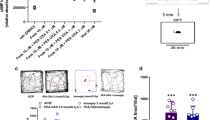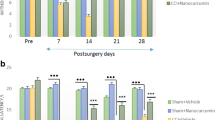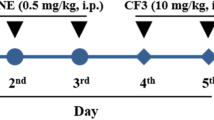Abstract
Patients suffering from neuropathic pain have a higher incidence of depression and cognitive decline. Although environment enrichment (EE) may be effective in the treatment of neuropathic pain, the precise mechanisms underlying its actions remain determined. The aim of the study was to examine the molecular mechanisms underlying the EE’s beneficial effects in mice with neuropathic pain. EE attenuated the pain threshold reduction, depression-like phenotype, and memory deficit in mice after chronic constriction injury (CCI). Furthermore, EE attenuated decreased neurogenesis and increased inflammation in the hippocampus of mice with neuropathic pain after CCI. Moreover, the suppression of adult hippocampal neurogenesis by temozolomide antagonized the beneficial effects of EE on depression-like phenotype and cognitive deficit in the mice with neuropathic pain. In addition, lipopolysaccharide-induced increase in tumor necrosis factor-α (TNF-α) in the hippocampus antagonized the beneficial effects of EE for these behavioral abnormalities in mice with neuropathic pain. Knock-down of NPAS4 (neuronal PAS domain protein 4) in the hippocampus by lentivirus targeting NPAS4 blocked these beneficial effects of EE in the mice with neuropathic pain. These all findings suggest that hippocampal NPAS4 plays a key role in the beneficial effects of EE on the pain sensitivity, depression-like phenotype, and memory deficit in mice with neuropathic pain. Therefore, it is likely that NPAS4 would be a new therapeutic target for perceptional, affective, and cognitive dimensions in patients with chronic pain.








Similar content being viewed by others
References
Alba-Delgado CL, Llorca-Torralba M, Horrillo I, Ortega JE, Mico JA, Sánchez-Blázquez P, Meana JJ, Berrocoso E (2013) Chronic pain leads to concomitant noradrenergic impairment and mood disorders. Biol Psychiatry 73:54–62
Almeida C, DeMaman A, Kusuda R, Cadetti F, Ravanelli MI, Queiroz AL, Sousa TA, Zanon S, Silveira LR, Lucas G (2015) Exercise therapy normalizes BDNF upregulation and glial hyperactivity in a mouse model of neuropathic pain. Pain 156:504–513
Apkarian AV, Mutso AA, Centeno MV, Kan L, Wu M, Levinstein M, Banisadr G, Gobeske KT, Miller RJ, Radulovic J, Hen R, Kessler JA (2016) Role of adult hippocampal neurogenesis in persistent pain. Pain 157:418–428
Bair MJ, Robinson RL, Katon W, Kroenke K (2003) Depression and pain comorbidity: a literature review. Arch Intern Med 163:2433–2445
Bloodgood BL, Sharma N, Browne HA, Trepman AZ, Greenberg ME (2013) The activity-dependent transcription factor NPAS4 regulates domain-specific inhibition. Nature 503:121–125
Bobinski F, Ferreira TA, Córdova MM, Dombrowski PA, da Cunha C, Santo CC, Poli A, Pires RG, Martins-Silva C, Sluka KA, Santos AR (2015) Role of brainstem serotonin in analgesia produced by low-intensity exercise on neuropathic pain after sciatic nerve injury in mice. Pain 156:2595–2606
Bushnell MC, Case LK, Ceko M, Cotton VA, Gracely JL, Low LA, Pitcher MH, Villemure C (2015) Effect of environment on the long-term consequences of chronic pain. Pain 156:S42–S49
Choy FC, Klarić TS, Koblar SA, Lewis MD (2015) The role of the neuroprotective factor Npas4 in cerebral ischemia. Int J Mol Sci 16:29011–29028
Choy FC, Klarić TS, Leong WK, Koblar SA, Lewis MD (2016) Reduction of the neuroprotective transcription factor Npas4 results in increased neuronal necrosis, inflammation and brain lesion size following ischaemia. J Cereb Blood Flow Metab 36:1449–1463
Clemenson GD, Stark CE (2015) Virtual environmental enrichment through video games improves hippocampal-associated memory. J Neurosci 35:16116–16125
Dellarole A, Morton P, Brambilla R, Walters W, Summers S, Bernardes D, Grilli M, Bethea JR (2014) Neuropathic pain-induced depressive-like behavior and hippocampal neurogenesis and plasticity are dependent on TNFR1 signaling. Brain Behav Immun 41:65–81
Dersh J, Polatin PB, Gatchel RJ (2002) Chronic pain and psychopathology: research findings and theoretical considerations. Psychosom Med 64:773–786
Duric V, McCarson KE (2006) Persistent pain produces stress-like alterations in hippocampal neurogenesis and gene expression. J Pain 7:544–555
Egeland M, Guinaudie C, Du Preez A, Musaelyan K, Zunszain PA, Fernandes C, Pariante CM, Thuret (2017) Depletion of adult neurogenesis using the chemotherapy drug temozolomide in mice induces behavioural and biological changes relevant to depression. Transl Psychiatry 7:e1101
Ellis A, Bennett DL (2013) Neuroinflammation and the generation of neuropathic pain. Br J Anaesth 111:26–37
Fiore NT, Austin PJ (2016) Are the emergence of affective disturbances in neuropathic pain states contingent on supraspinal neuroinflammation? Brain Behav Immun 56:397–411
Gerard E, Spengler RN, Bonoiu AC, Mahajan SD, Davidson BA, Ding H, Kumar R, Prasad PN, Knight PR, Ignatowski TA (2015) Chronic constriction injury-induced nociception is relieved by nanomedicine-mediated decrease of rat hippocampal tumor necrosis factor. Pain 156:1320–1333
Gonçalves L, Silva R, Pinto-Ribeiro F, Pêgo JM, Bessa JM, Pertovaara A, Sousa N, Almeida A (2008) Neuropathic pain is associated with depressive behaviour and induces neuroplasticity in the amygdala of the rat. Exp Neurol 213:48–56
Grace PM, Fabisiak TJ, Green-Fulgham SM, Anderson ND, Strand KA, Kwilasz AJ, Galer EL, Walker FR, Greenwood BN, Maier SF, Fleshner M, Watkins LR (2016) Prior voluntary wheel running attenuates neuropathic pain. Pain 157:2012–2023
Grilli M (2017) Chronic pain and adult hippocampal neurogenesis: translational implications from preclinical studies. J Pain Res 10:2281–2286
Gui WS, Wei X, Mai CL, Murugan M, Wu LJ, Xin WJ, Zhou LJ, Liu XG (2016) Interleukin-1β overproduction is a common cause for neuropathic pain, memory deficit, and depression following peripheral nerve injury in rodents. Mol Pain 12:12
Hannan AJ (2014) Environmental enrichment and brain repair: harnessing the therapeutic effects of cognitive stimulation and physical activity to enhance experience-dependent plasticity. Neuropathol Appl Neurobiol 40:12–25
Hart RP, Wade JB, Martelli MF (2003) Cognitive impairment in patients with chronic pain: the significance of stress. Curr Pain Headcare Rep 7:116–126
Jaehne EJ, Klarić TS, Koblar SA, Baune BT, Lewis MD (2015) Effects of Npas4 deficiency on anxiety, depression-like, cognition and sociability behaviour. Behav Brain Res 281:276–282
Kempermann G, Kuhn HG, Gage FH (1997) More hippocampal neurons in adult mice living in an enriched environment. Nature 386:493–495
Kempermann G, Gast D, Gage FH (2002) Neuroplasticity in old age: sustained fivefold induction of hippocampal neurogenesis by long-term environmental enrichment. Ann Neurol 52:135–143
Kiguchi N, Kobayashi Y, Kishioka S (2012) Chemokines and cytokines in neuroinflammation leading to neuropathic pain. Curr Opin Pharmacol 12:55–61
La Porta C, Lara-Mayorga IM, Negrete R, Maldonado R (2016) Effects of pregabalin on the nociceptive, emotional and cognitive manifestations of neuropathic pain in mice. Eur J Pain 20:1454–1466
Levone BR, Cryan JF, O’Leary OF (2014) Role of adult hippocampal neurogenesis in stress resilience. Neurobiol Stress 1:147–155
Malfliet A, Coppieters I, Van Wilgen P, Kregel J, De Pauw R, Dolphens M, Ickmans K (2017) Brain changes associated with cognitive and emotional factors in chronic pain: a systematic review. Eur J Pain 21:769–786
Martuscello RT, Spengler RN, Bonoiu AC, Davidson BA, Helinski J, Ding H, Mahajan S, Kumar R, Bergey EJ, Knight PR, Prasad PN, Ignatowski TA (2012) Increasing TNF levels solely in the rat hippocampus produces persistent pain-like symptoms. Pain 153:1871–1882
Mo C, Hannan AJ, Renoir T (2015) Environmental factors as modulators of neurodegeneration: insights from gene-environment interactions in Huntington’s disease. Neurosci Biobehav Rev 52:178–192
Moriarty O, McGuire BE, Finn DP (2011) The effect of pain on cognitive function: a review of clinical and preclinical research. Prog Neurobiol 93:385–404
Nithianantharajah J, Hannan AJ (2006) Enriched environments, experience-dependent plasticity and disorders of the nervous system. Nat Rev Neurosci 7:697–709
Olson AK, Eadie BD, Ernst C, Christie BR (2006) Environmental enrichment and voluntary exercise massively increase neurogenesis in the adult hippocampus via dissociable pathways. Hippocampus 16:250–260
Ren WJ, Liu Y, Zhou LJ, Li W, Zhong Y, Pang RP, Xin WJ, Wei XH, Wang J, Zhu HQ, Wu CY, Qin ZH, Liu G, Liu XG (2011) Peripheral nerve injury leads to working memory deficits and dysfunction of the hippocampus by upregulation of TNF-α in rodents. Neuropsychopharmacology 36:979–992
Sahay A, Hen R (2007) Adult hippocampal neurogenesis in depression. Nat Neurosci 10:1110–1115
Shepard R, Heslin K, Coutellier L (2017) The transcription factor Npas4 contributes to adolescent development of prefrontal inhibitory circuits, and to cognitive and emotional functions: implications for neuropsychiatric disorders. Neurobiol Dis 99:36–46
Snyder JS, Soumier A, Brewer M, Pickel J, Cameron HA (2011) Adult hippocampal neurogenesis buffers stress responses and depressive behavior. Nature 476:458–461
Sun X, Lin Y (2016) Npas4: linking neuronal activity to memory. Trends Neurosci 39:264–275
Then FS, Luck T, Luppa M, König HH, Angermeyer MC, Riedel-Heller SG (2015) Differential effects of enriched environment at work on cognitive decline in old age. Neurology 84:2169–2176
Vachon P, Millecamps M, Low L, Thompsosn SJ, Pailleux F, Beaudry F, Bushnell CM, Stone LS (2013) Alleviation of chronic neuropathic pain by environmental enrichment in mice well after the establishment of chronic pain. Behav Brain Funct 9:22
Vasic V, Schmidt MH (2017) Resilience and vulnerability of pain and inflammation in the hippocampus. Int J Mol Sci 18:E739
Wang X-M, Pan W, Xu N, Zhou Z-Q, Zhang G-F, Shen J-C (2019) Environmental enrichment improves long-term memory impairment and aberrant synaptic plasticity by BDNF/TrkB signaling in nerve-injured mice. Neurosci Lett 694:93–98
Williamson LL, Chao A, Bilbo SD (2012) Environmental enrichment alters glial antigen expression and neuroimmune function in the adult rat hippocampus. Brain Behav Immun 26:500–510
Wren AA, Wright MA, Carson JW (2011) Yoga for persistent pain: new findings and directions for an ancient practice. Pain 152:477–480
Wu J, Zhao Z, Sabirzhanov B, Stoica BA, Kumar A, Luo T, Skovira J, Faden AI (2014) Spinal cord injury causes brain inflammation associated with cognitive and affective changes: role of cell cycle pathways. J Neurosci 34:10989–11006
Xu X, Zheng J, Zhang J, Chne X, Yang P, Liu J, Liu Y (2013) Neurogenesis in the dentate gyrus of the hippocampus in a rat model of intracerebral hemorrhage. Nan Fang Yi Ke Da Xue Xue Bao 33:1437–1441 Chinese
Yang J, Lai B, Xu A, Liu Y, Li X, Zhao Y, Li W, Ji M, Hu G, Gao X, Gao J (2015) Maged1 co-interacting with CREB through a hexapeptide repeat domain regulates learning and memory in mice. Mol Neurobiol 51:8–18
Yun J, Koike H, Ibi D, Toth E, Mizoguchi H, Nitta A, Yoneyama M, Ogita K, Yoneda Y, Nabeshima T, Nagai T, Yamada K (2010) Chronic restraint stress impairs neurogenesis and hippocampus-dependent fear memory in mice: possible involvement of a brain-specific transcription factor Npas4. J Neurochem 114:1840–1851
Zheng J, Jiang YY, Xu LC, Ma LY, Liu FY, Cui S, Cai J, Liao FF, Wan Y, Yi M (2017) Adult hippocampal neurogenesis along the dorsoventral axis contributes differentially to environmental enrichment combined with voluntary exercise in alleviating chronic inflammatory pain in mice. J Neurosci 37:4145–4157
Funding
This study was supported by a grant from the National Natural Science Foundation of China (to Z.Q.Z., no. 81571083, and J.J.Y., no. 81471105).
Author information
Authors and Affiliations
Corresponding authors
Ethics declarations
This study was approved by the Ethics Committee of Zhongda Hospital, Nanjing, China, and performed in accordance with the Guide for the Care and Use of Laboratory.
Conflict of interest
The authors declare that they have no competing interests.
Additional information
Publisher’s note
Springer Nature remains neutral with regard to jurisdictional claims in published maps and institutional affiliations.
Electronic supplementary material
Supplemental Figure 1
Cages for animal housing. Mice were housed in the environmental enrichment (EE) cage (60× 40 × 20 cm) and standard enrichment (SE) cage (30× 20 × 10 cm) mice lived. (PNG 813 kb)
Supplemental Figure 2
Treatment of TMZ decreased hippocampal neurogenesis in adult mice. A, B: Number of BrdU and Ki67 positive cells in the TMZ treated group was significantly decreased compared with control group. The values are the mean ± S.E.M. *P < 0.05, compared with the control group. The detailed statistical analyses are in the supplemental Table 1. Scale bar: 100 μm. (PNG 3064 kb)
Rights and permissions
About this article
Cite this article
Wang, Xm., Zhang, Gf., Jia, M. et al. Environmental enrichment improves pain sensitivity, depression-like phenotype, and memory deficit in mice with neuropathic pain: role of NPAS4. Psychopharmacology 236, 1999–2014 (2019). https://doi.org/10.1007/s00213-019-5187-6
Received:
Accepted:
Published:
Issue Date:
DOI: https://doi.org/10.1007/s00213-019-5187-6




